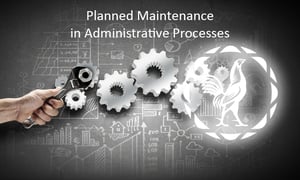 As I mentioned in my previous post, I will here continue with the next 4 steps to take for the implementation of Planned Maintenance in the Administrative Processes, which are:
As I mentioned in my previous post, I will here continue with the next 4 steps to take for the implementation of Planned Maintenance in the Administrative Processes, which are:- Step 4.- General Inspection of Quality Function
- Step 5.- Improvement of the Inspection and the Maintenance Efficiency
- Step 6.- Carrying out Predictive Maintenance
- Step 7.- Horizontal Replication
As I mentioned before, the challenge that we faced when applying Planned Maintenance (PM) was how to apply something that usually works with machinery, breakdowns, equipment, inspections, to a totally different area, one that works with documents, administrative processes, written reports and the such.
Steps 1 to 3
To recap a little: the first 3 steps will help us know the current status of our processes, that is to say, how many activities do we carry out, during how long, and with whom are they carried out. In addition, they also help me know my Master Plan on the activities need to be done (and their due date) and on the implementation of certain improvements that has been already programmed, so I do not forget to carry all this out (and when). We also get to know about the last step that was verified, with which we will measure our tentative standards (time given to carry out an activity, which will also have to be constantly improved; It is not about changing due dates, rather about reducing the time that it takes to carry out an activity).
Let's cut to the chase and analyze the last 4 steps (out of 7) in order to have a general vision of the implementation of Planned Maintenance to the Administrative Processes.
Step 4.- General inspection of Quality Function
When we already know the activities that we need to carry out and the time we have for it, it's time to analyze each one of them so we are 100% sure that they can be achieved in proper time and manner. This will help us go from a "total loss of operations due to failures" to a "gradual loss". Since we won't be able to carry out some of the activities presented in the Master Plan, we might focus in other minor changes/losses, probably related to external causes. We will focus on actions that keep the quality of our processes, which will be measured by the number of process that we can carry out in a timely manner.
Step 5.- Improvement of the Inspection and the Maintenance Efficiency
Once the tentative standards of Step 3 have been achieved and our processes analyzed in Step 4, we must assure the reliable execution of the Predictive Maintenance and the reduction of time given for their accomplishment.
And How do We do It?
- Analyzing our process in search of the improvements need to assure the reduction of time spent in carrying out activities.
- Making sure that the completion of the process is achieved in the stipulated time (New Tentative Standards)
This is how we build the maturity of our process.
Step 6.- Carrying out Predictive Maintenance
In this step, we will focus on those activities that have a greater impact in reaching our goal, which is to have zero breakdowns. Let's not forget that to us, this means to meet the dates that were mentioned before.
"Remember that Predictive Maintenance aims to optimize the maintenance period by means of monitoring the failures trends."
Once that the activities that were not carried out in proper time are identified, we will create a Master Plan to modify them according to the opportunity areas that we observed existed. In other words, we will generate an improvement of the activity so that, when it becomes necessary to carry out the process again, this failure doesn't happen once more.
Step 7.- Horizontal Replication
This last stage is the culmination of the activities that were carried out, one at which our process is so mature and without completion, that it will serve as a model for the replication of the methodology carried out, in the many processes that our colleagues carry out or in our same area.
This is how we finish with the post: The Application of Planned Maintenance in Administrative Processes. Everything here is an adaptation of the knowledge obtained during our TPM development. If you want to know more about our processes, you can always come and visit Casa Sauza so you see it all for yourself. We'd be happy to have you here!
.png?width=50&height=50&name=10.CS-Redondo%20(1).png)

